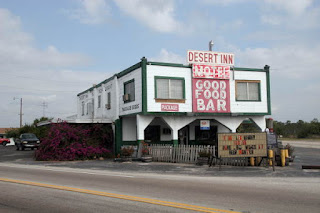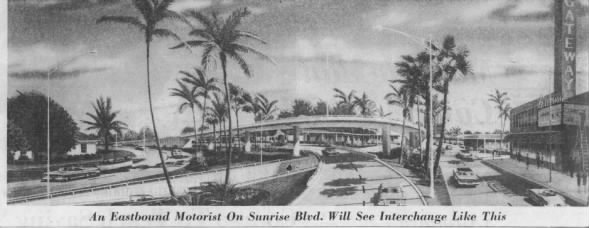 |
| Galt area 1950s State Archives/ of Florida/ Florida Memory |
By Jane Feehan
The mile-long strip of land known as the Galt Mile was sold in 1953 by Arthur T. Galt for $19 million to James S. Hunt and Stephen A. Calder, heralding the first development phase of that area. The first hotel to go up on this golden mile was the Beach Club Hotel.
The Beach Club, first an exclusive private club along the beach at Oakland Park Boulevard, was purchased in July 1956 by Eugene Ballard and L. Bert Stephens, owners/managers of the Lago Mar Hotel.
Ben Chavez Construction connected the old Beach Club building to a new, 150-room (some accounts say 200-room) wing. The Chanticleer cocktail lounge in the old building and the new, outdoor Carousel Bar, shuffleboard courts and saltwater pool were included in hotel offerings when it opened Dec. 22, 1956.
Its “tropical architecture” motif served as backdrop to an array of civic club meetings, a busy calendar of winter season parties and year-round memberships to its pool and roster of family activities. In May 1957, five months after opening, the Beach Club Hotel hosted the Mrs. America contest for 10 days.
And there was the Woody Woodbury connection.
The popular Fort Lauderdale entertainer is often remembered for his appearances at other hotels along Fort Lauderdale beach, including the Bahama Hotel, but he appeared (and ran things) at the Lulubelle Room at the Beach Club Hotel for 10 years, his longest run anywhere.
Woodbury’s last show at the Lulubelle was July 21, 1984 where he bid farewell to about 200 fans—the B.I.T.O.A. club or “Booze is the Only Answer” club. Many thought he would soon move to California, but he remained in the Fort Lauderdale area (Plantation).
Woody re-appeared months later at the Rum Room at the Galt Ocean Mile Hotel and elsewhere in Fort Lauderdale and other cities before he actually called it quits.
The opening of the Beach Club was soon followed by the Galt Ocean Mile Hotel in 1957. But, by the mid-1980s, both were shuttered to make way for new projects—for what I call the second development phase for the Galt, the condominium era. A 500-room Hilton Hotel was proposed for the Beach Club Hotel site but made some on the city’s zoning board nervous about potential traffic problems (they should see Fort Lauderdale now, where traffic problems no longer matter). After several years of lying vacant, the old Beach Club site was developed into two 27-story towers of L’Hermitage Condominium.
Sources:
Fort Lauderdale News, Oct. 27, 1956
Fort Lauderdale News, Dec. 20, 1956
Fort Lauderdale News, May 2, 1957
Fort Lauderdale News, Dec. 19, 1975
Fort Lauderdale News, July 24, 1984
Fort Lauderdale News, March 29, 1985
Tags: Beach Club Hotel, Galt Ocean Mile, Woody Woodbury, B.I.T.O.A. club, Fort Lauderdale history
Tags: Beach Club Hotel, Galt Ocean Mile, Woody Woodbury, B.I.T.O.A. club, Fort Lauderdale history








